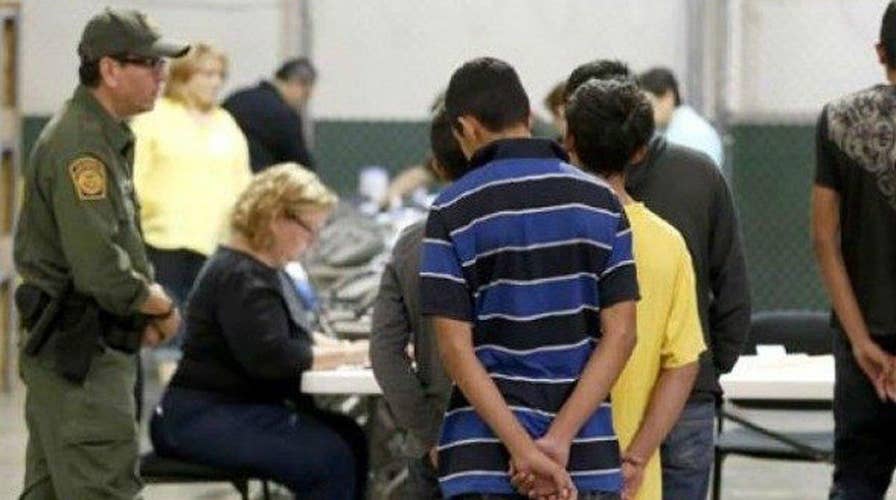Sanctuary city pols to pay for illegal immigrant crimes?
Colorado lawmaker proposes a bill that would let victims of crimes committed by illegal immigrants sue politicians in sanctuary cities #Tucker
It was 1986 and Los Angeles was desperate to curb the high recidivism rate of illegal immigrants in its jail who had been costing taxpayers millions every year.
A solution was devised for what one RAND study later called a “revolving door for criminal aliens”: have a federal agent work out of the nation’s largest jail to identify illegal immigrants and ensure repeat offenders, some of them violent felons, were placed on a bus bound for the border instead of released into the community.
For roughly 16 years, Los Angeles did exactly that, hosting federal immigration officers at the jail. This, combined with promises of more agents at the border, was supposed to tackle the illegal immigration problem.
It didn't work out that way. The all-but-forgotten Los Angeles program underscores a striking contrast with the level of cooperation today.
Thirty years later, policies have taken a 180-degree turn. Immigration and Customs Enforcement abandoned its jail office after 9/11 because of a redeployment to fight terrorism. A state measure passed by ballot vote in 1994 barring illegal immigrants from receiving public benefits was overturned by a federal court after intense lobbying by immigrants’ rights groups with increasing political clout. In 2015, Los Angeles County enacted an official policy to not ask people about immigration status, a policy the city technically had enacted in 1979.
A showdown with President Trump appears inevitable, as the sheriff’s office maintains its ‘don’t ask’ approach.
“We're not providing them any longer with any lists of individuals that are being released. It's up to ICE agents to vet through that process and they identify the inmates they are interested in,” Assistant Sheriff Kelly Harrington declared following a recent meeting of the Board of Supervisors to discuss the formation of a new Office of Immigrant Affairs to aid immigrants in obtaining public services.
Sheriff Jim McDonnell added: “My deputies will not initiate any police activity nor arrest anyone based solely on their immigration status. It's our promise, it's written in our department policy and it's the law.”
No California law prohibits law enforcement from arresting a person for being in the state illegally, but a pair of laws enacted in 2013 and 2016 gives immigrants a right to refuse a police interview and law enforcement was given the “discretion to cooperate with federal immigration officials by detaining an individual on the basis of an immigration hold after that individual becomes eligible for release from custody.”
The earlier law was fueled by allegations of excessive wait times while the government received no federal compensation.
“Los Angeles spent $26 million a year holding immigrants for ICE before 2012,” said Alex Nowrasteh, an immigration policy analyst at the Cato Institute. “For the entire state, it was $65 million. The feds would drag their feet and had no reason to hurry and the state would be on the hook for the extra money. So the state decided they had enough of that.”
The Sheriff's Department says it is doing its best to comply with all laws.
“People believe we have this broad ability to enforce all these laws, but there is case law that says what we can and cannot do,” said Sheriff's Capt. Jeff Scroggin. “Federal case law says local law enforcement has no jurisdiction over a person's immigration status because it is a civil action of the U.S. government.”
A Different Era
Tensions weren’t always so high. Former Los Angeles County Supervisor and reserve police officer Michael Antonovich, one of the creators of the system to put immigration agents at the jail, said law enforcement and local lawmakers years ago saw the impact illegal immigration had on the economy and safety.
“We knew we had to work together to stop this because it wasn't fair to the taxpayers,” he said. “We were working cooperatively for one goal – to keep communities safe.”
Deportable immigrants made up 11 percent of the jail population or 22,000 people in 1990, a figure that rose to 17 percent in 1995, according to the 2004 RAND study. In 2000, $2.3 million in federal funds were awarded for a computer and fingerprinting system to catalog illegal immigrants, focusing on previously deported felons. Within one year, 40 percent of the immigrants identified in 1990 and 1995 had been rearrested.
“These findings gave credence to views that deportable aliens were imposing a substantial burden on the local criminal justice system,” the study said.
Despite great optimism in Los Angeles for the program – which had spread nationwide – there were signs then that the state of California would not be a willing partner.
“California has done little to help the INS streamline the Institutional Removal Program process beyond the initial program enhancements,” according to a 2002 audit by the Immigration and Naturalization Service, the predecessor to today’s federal immigration agencies. “As a result, INS agents must maintain an active presence at 11 intake facilities dispersed throughout the state over an area roughly 120,000 square miles in size.”
Criticism also went to the INS, which did not “effectively manage” the program and pulled immigration agents away from their duties to work on other types of cases. A severe personnel shortage ensued resulting in the release of targeted immigrants, including aggravated felons.
Climate of Division
As California shifted more to the left, the already antiquated notion of cooperation among law enforcement, local lawmakers, the state Legislature and the U.S. government evaporated. The resistance has only deepened in recent years. Now, taxpayers will be funding a Los Angeles government agency that gives illegal immigrants access to free legal services to fight deportation. Law enforcement will be monitored to make sure they adhere to “immigrant-friendly” policies.
Police agencies across the state have put out the message that they are interested in solving crime and not acting as a deportation force.
“We want everybody to come to us and help us with crime tips, that’s why we don’t care about immigration status,” Scroggin said. “We need the cooperation of the public in general. We have 4,000 miles to patrol.”
Even though the ICE office space is long gone, ICE agents are welcome to come into the jail and access computers and printouts that reveal inmate release data. But the cooperation is limited.
“It’s up to ICE to decide if the person fits the bill to deport or detain,” Scroggin said. “We make the list available, but we aren’t federal immigration agents. We definitely want violent felons off the streets, but once the sentence is done and charges dropped, we have no other option to release them without suffering potential liability issues.”
Liabilities could include excess medical costs or lawsuits if the inmate is harmed while waiting for ICE.
“All of this is totally irresponsible,” Antonovich countered. “Law enforcement personnel take an oath to support the federal and state constitutions. Immigration is a federal policy. [California] is like Jefferson Davis where they are going to form their own Confederacy and rebel against the federal government. Trump is like Abraham Lincoln in trying to stop this.”





